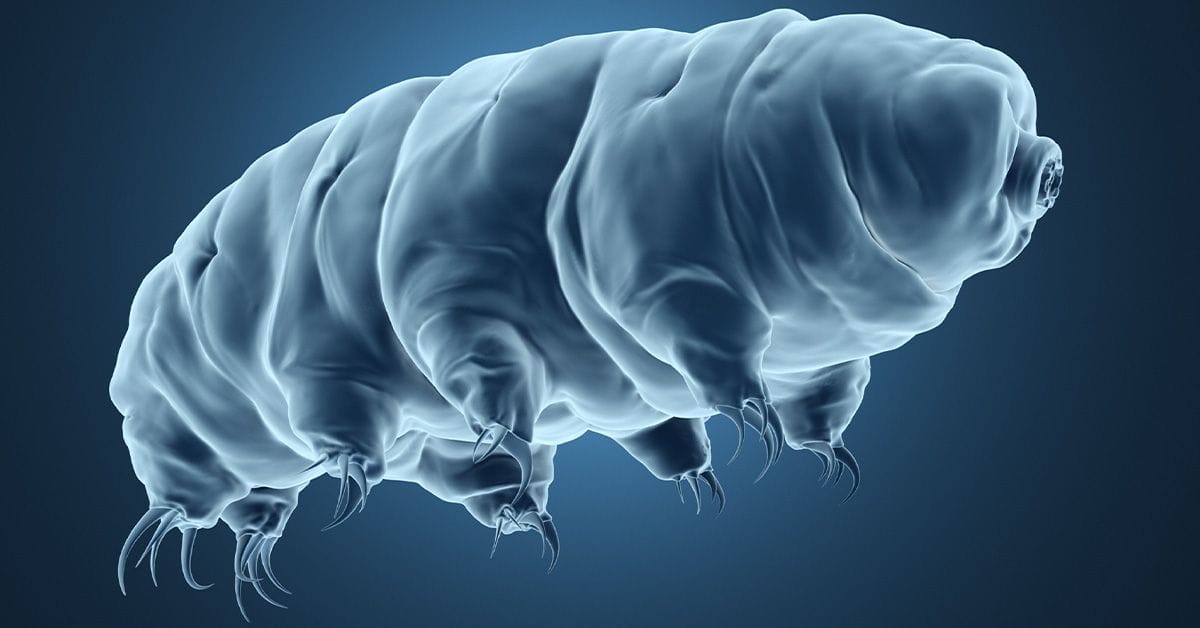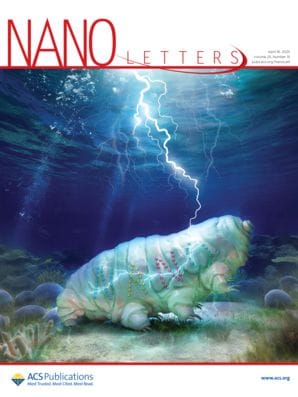Tardigrades, also known as water bears, can go decades without food or water and thrive in extreme temperatures—and scientists are leveraging their near-indestructible nature to test a new biocompatible patterning technique.

There is a general trend towards the miniaturization of electronic devices, which requires 3D printing at the nanometer scale.1 Being able to incorporate patterns such as electrodes and circuits into micro- and nanoscale biological systems has huge potential for developing intelligent sensing and control devices. The idea essentially merges electronics, photonics, and stimuli-responsive materials. We’ve looked before at e-tattoos for wearables and even flash tattoos on living cells. However, a key challenge is that most lifeforms are incompatible with traditional fabrication methods for these patterns, such as etching, high-temperature baking, toxic solvents, lasers, or vacuum-based techniques.2,3 But tardigrades—commonly known as "water bears"—defy these limitations with extraordinary resilience.4 These tiny creatures take everyday biological assaults in eight-legged stride, surviving decades without food or water and enduring both extreme temperatures and the vacuum of space. And scientists are taking advantage of their near-indestructible nature to test a new microfabrication technique with potential for building microscopic, biocompatible devices.

Nanoscience Gives New Meaning to "Flash Tattoo”
To demonstrate this, new work published in Nano Letters presents a way of using ice lithography to tattoo micro- and nanoscale patterns onto tardigrades when they are in a cryptobiotic state.5 Ice lithography is done at cryogenic temperatures, allowing vaporized chemicals to condense on to the sample surface and form conformal electron resists. In 2012, a group at Harvard University showed that using amorphous water ice as an e-beam resist could create nanodevice structures on nonplanar or fragile substrates.6 With carefully selected accelerating voltage, electron dose, and ice thickness, 3D objects can be efficiently printed in a single vacuum system through an iterative process of ice deposition and e-beam exposure.
Building upon these ideas, the team cooled the cryptobiotic tardigrade sample to <130 K (<-225° F) before vaporized anisole was condensed onto it, forming a thin layer of amorphous film. A focused electron beam then irradiated the film in a predetermined pattern, locally modifying the chemical composition of the anisole. Aromatic molecules such as anisole have been explored by the team before, with results showing that they can be directly converted into graphene quantum dot nanostructures by cryogenic electron-beam writing.7 Patterns tested in the new tardigrade study included nanowire, microdisk, and square arrays—and custom designs such as the Westlake University logo. The tardigrade sample was then gradually heated to room temperature in a vacuum, causing the unexposed anisole to sublimate, leaving the designed nanostructures intact. After tattooing, the tardigrade was removed from the scanning electron microscope chamber and revived via rehydration.

The results showed that the patterns were retained after this process. By precisely controlling ice thickness, beam energy, and substrate properties, this method minimizes damage to the tardigrades and manages to create patterns as small as 72 nm—which remain stable even after stretching, solvent immersion, rinsing, and drying.

Patterning on Living Tardigrades
DOI: 10.1021/acs.nanolett.5c00378
The authors note that this approach provides new insights into the resilience of these remarkable creatures, demonstrating potential applications in cryopreservation, biomedicine, and astrobiology: “Through this technology, we’re not just creating micro-tattoos on tardigrades—we’re extending this capability to various living organisms, including bacteria,” explains Ding Zhao, a co-author of the paper, in a recent press release. Watch out—these tattooed little water bears may be paving the way for a new era of biologically integrated nanotechnology.
Explore Related Articles in ACS Journals
Precise Fabrication of Graphite-Like Material Directly on a Biological Membrane Enabled by Ethanol Ice Resist
Dylan A. Chiaro, Travis J. Hager, Kyle T. Renshaw, Bailey M. Moore, Arash Ghobadi, Rubaiyet I. Haque, Anpan Han, Bernadette M. Broderick*, Suchismita Guha*, and Gavin M. King*
DOI: 10.1021/acs.nanolett.5c01265
Ultrathin and Breathable Silk-Protein Electronic Tattoos for Iontophoretic Transdermal Drug Delivery
Shalik Ram Joshi, Hyunji Lee, Soohoon Lee, Juwan Choi, and Sunghwan Kim*
DOI: 10.1021/acsapm.5c00164
Freestanding Transparent Organic–Inorganic Mesh E-Tattoo for Breathable Bioelectrical Membranes with Enhanced Capillary-Driven Adhesion
Xiang Li, Junyi Zhang, Bo Shi, Yawen Li, Yanan Wang, Kexiang Shuai, Yue Li, Gege Ming, Tao Song*, Weihua Pei*, and Baoquan Sun*
DOI: 10.1021/acsami.5c00565
Nanofabrication for Nanophotonics
Younghwan Yang, Youngsun Jeon, Zhaogang Dong, Joel K. W. Yang, Mahsa Haddadi Moghaddam, Dai-Sik Kim, Dong Kyo Oh, Jihae Lee, Mario Hentschel, Harald Giessen, Dohyun Kang, Gyeongtae Kim, Takuo Tanaka, Yang Zhao, Johannes Bürger, Stefan A. Maier, Haoran Ren, Wooik Jung, Mansoo Choi, Gwangmin Bae, Haomin Chen, Seokwoo Jeon, Jaekyung Kim, Eunji Lee, Hyunjung Kang, Yujin Park, Dang Du Nguyen, Inki Kim, Pablo Cencillo-Abad, Debashis Chanda, Xinxin Jing, Na Liu, Irina V. Martynenko, Tim Liedl, Yuna Kwak, Jwa-Min Nam, Sang-Min Park, Teri W. Odom, Hye-Eun Lee, Ryeong Myeong Kim, Ki Tae Nam, Hyunah Kwon, Hyeon-Ho Jeong, Peer Fischer, Jiwon Yoon, Shin-Hyun Kim, Sangmin Shim, Dasol Lee, Luis A. Pérez, Xiaoyu Qi, Agustin Mihi, Hohyun Keum, Moonsub Shim, Seok Kim, Hanhwi Jang, Yeon Sik Jung, Christian Rossner, Tobias A.F. König, Andreas Fery, Zhiwei Li, Koray Aydin, Chad A. Mirkin, Junhwa Seong, Nara Jeon, Zhiyun Xu, Tian Gu, Juejun Hu, Hyounghan Kwon, Hojoong Jung, Hossein Alijani, Igor Aharonovich, Joohoon Kim, and Junsuk Rho*
DOI: 10.1021/acsnano.4c10964
Bacterial Patterning: A Promising Biofabrication Technique
Minghui Xiao, Shuyi Lv, and Chunlei Zhu*
DOI: 10.1021/acsabm.4c00056
E-Tattoos: Toward Functional but Imperceptible Interfacing with Human Skin
Hongbian Li, Philip Tan, Yifan Rao, Sarnab Bhattacharya, Zheliang Wang, Sangjun Kim, Susmita Gangopadhyay, Hongyang Shi, Matija Jankovic, Heeyong Huh, Zhengjie Li, Pukar Maharjan, Jonathan Wells, Hyoyoung Jeong, Yaoyao Jia, and Nanshu Lu*
DOI: 10.1021/acs.chemrev.3c00626
References
- Wu, S. et al. 3D Nanoprinting by Electron-Beam with an Ice Resist. ACS Appl. Mater. Interfaces 2022, 14, 1, 1652–1658.
- Grebenko, A. K. et al. Gentle Patterning Approaches toward Compatibility with Bio-Organic Materials and Their Environmental Aspects. Small 2022, 18 (22), e2200476.
- Hu, A. et al. Ultraelastic Lead Halide Perovskite Films via Direct Laser Patterning. ACS Nano 2025, 19, 2, 2286–2293.
- Cross, R. Secrets of the tardigrade. C&EN, 2016, 94 (44), pp 20–21.
- Yang, Z. et al. Patterning on Living Tardigrades. Nano Lett. 2025, 25, 15, 6168–6175.
- Han A, et al. Nanopatterning on Nonplanar and Fragile Substrates with Ice Resists. Nano Lett. 2012, 12 (2), 1018–1021.
- Lu, Y. et al. Production and Patterning of Fluorescent Quantum Dots by Cryogenic Electron-Beam Writing. ACS Appl. Mater. Interfaces 2023, 15, 9, 12154–12160.
